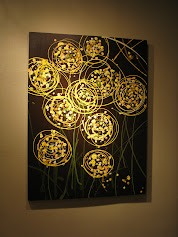One of the most rewarding things about "working" this blog, is that that I've met some amazing people through the blogosphere. Since BEES and HONEY are used metaphorically around here, I find it most interesting that the universe continues to send me new friends who are teaching me so much about the magical world of REAL bees...
Enter Seth Machak. A honey of a guy, who actually is a magician. He also happens to be a beekeeper, and a bee-charmer for sure. I recently spied his post on Facebook, chronicling his candle making endeavors, and asked him if he wouldn't mind sharing it with all of you here. He was kind enough to oblige.
MPM: Speaking of magic, how did Seth discover the magic of bees?
SM: A very close friend of mine and I went to a VERY small county fair about an hour from where I live... in the midst of deep fried cheese cake, chili bread bowls, cotton candy, candied apples, deep fried Oreo cookies and funnel cakes, we noticed a small booth with an "Observation Hive" -one hive frame encased in Plexiglas [You are able to see the inter workings of the hive, queen and her subjects]. It caught my attention!
After an hour of bombarding the poor booth attendee with questions upon questions, he finally gave me a pamphlet and told me to sign up for the county bee keeping association. The classes didn't start for a few months, so it gave me time to do some research on bee keeping . My friend and I finally decided to give in, and paid $50 to try it out! We went to bi-weekly classes for a number of months. When "graduation" time came. I KNEW whole-heartedly that keeping bees was going to be my new hobby... Little did I know it would be a lifestyle!
After starting with 2 hives, I couldn't get enough. It was like mother natures crack., and I was hooked. The smell, the sound, the way "my girls" would dance in the air. It's magical. Did you know that EVERY honey bee you see on a flower is a girl? They are the workers, they are the foragers, they do ALL the work- while the boys (drones) just sit back, eat, maybe have sex with the queen and die... Not a bad life I suppose!
MPM: Tell me about your apiary. Wait, why don't you explain what an apiary is!
SM: Webster unabridged dictionary says and Apiary is a place where bees are kept; a collection of beehives. My apiary, now, has a collection of 3 hives... as of now I have a total of 45,000 honey bees. As well, established hives can have up to 300,000 members!
One colony lives in a hive. A hive consists of many different parts. First is the bottom board. Then comes the deep supers, or brood boxes. There should be two of them. What those boxes are/do are ALL for the bees themselves. They are empty boxes with no top or bottom, and contain 10 frames. A frame is basically a wooden rectangle with a thin sheet of bees wax in the middle of it. This sheet gives the girls a good foundation to "draw out", AKA build it up with comb. It's actually very interesting. The bees will drink nectar which then somehow gets all processed inside of the them. When ready, it becomes wax scales that form from the undersides of the workers. When these wax suits of armor start coming out, the girls with nibble it off , mix it with some enzymes in their mouths, and then spit it out on the foundation, making a perfectly symmetrical six sided wax cell. All cells, from all hives from all around the world, are ALL THE EXACT SAME SIZE!
When the workers have "drawn out" on all ten frames in the bottom brood box , the queen is then ready to lay her eggs, and the workers will fill some cells with pollen and nectar. This will be food for the hive during the winter. When almost all the bottom brood box is drawn out, it is time to add another brood box on top of that. After some time the two brood boxes will be all drawn out , and full of brood (food and larva), You add a queen excluder next.
The queen excluder is pretty self explanatory. It is a wire grate that you put on top of the top brood box, and it allows only the worker bees to get through. The queens fat ass is too big to get through the grate on top of the excluder, so you add a "honey -super, or "short -super." The point of the queen excluder and the short super, is so only the workers can go into the short super and make HONEY... The queen, who can't get through, will be unable to lay eggs there. You've probably guessed the honey in the short supers is the honey you will extract and then sell, give away , or eat yourself! I mean, who would want honey if it had little babees in it, right?
MPM: Any advice for someone who's got the itch start their own apiary?
SM: Anyone who is interested in starting their own hive, PLEASE, PLEASE, PLEASE read http://www.planbeebook.com/ ... One of the greatest bee keeping information sources of ALL TIME! Also, contact your local honey bee association. They will be able to tell you about classes and workshops in your area.
SM: Making my own candles 101... Last season I lost 2 of my hives dues to malnutrition and black bear attacks! So, in all of this tragedy, I had 2 established hives worth of wax. Just a few days ago I ripped out all the wax from the frames, rolled the wax and bee parts into a ball, wrapped them in nylons.
Next, you tie them off, and throw them into a pot of boiling water (not over 140 degrees because the wax will change color and smell different). The bees wax will melt and seep threw the nylon leaving the sediment (bee parts and larva and other gross stuff!) Bee keepers call this "slumgum".
Remove the nylon and let the water cool. The "rendered" wax will rise to the top and cool. Take that hardened wax and melt it again in a double boiler (keeping in mind the temperature) and re-melt it. When melted pour the liquefied wax into the molds or container which should already have wicks in the center (wicks can be purchased at any local craft store).
When the wax hardens you will have yourself the PERFECT candle.
If you don't have an apiary to get extra wax, you can contact a local beekeeper and buy wax from them or purchase bees wax from a local craft store.
MPM: Any chance I can get you to sell them to me wholesale, for my shop?
SM: I do NOT sell any of the honey, lip balm, or candles that I produce from the honey bee by-product. I usually give them away as gifts or something. One day I showed my residents ( I am an activities coordinator for an assisted living facility by day ) how to make their own chap stick... They loved it! We spent hours harvesting wax, rendering it, and turning it into our own little lip-skin saver!
MPM: And that, Seth Machak, is what makes you a Killer Bee. Keep on pollinating brother!






















1 comment:
Oh my God!!! I love him!!!!!! Stacey
Post a Comment